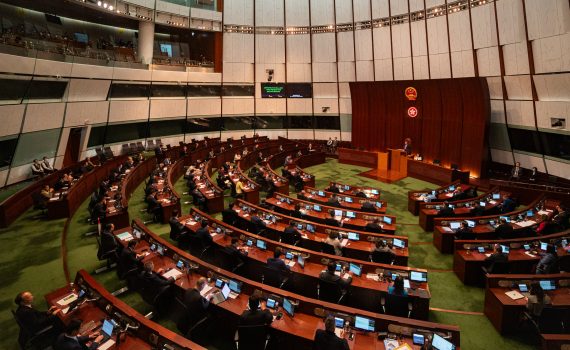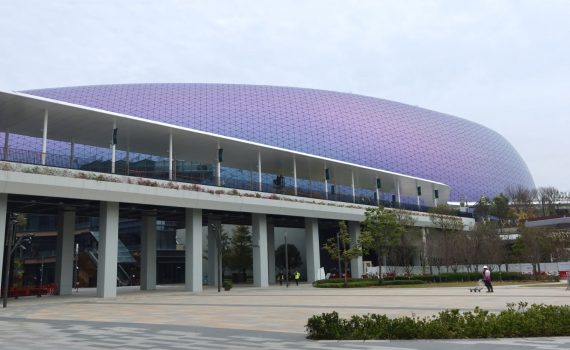TOP STORIES
Budget 2025: One-year civil servants pay freeze
- 2025-02-26
- Politics
- The Young Reporter
- By: Fu Rong、Chun Hei LUKEdited by: Wing Chi HO
- 2025-02-26
More than 170,000 civil servants and all members of the executive, legislative and judicial branches of the government will not see a pay rise for a year. Up to 10,000 civil service posts will be axed. (February 26, 2025).
Budget 2025: Hong Kong Tourism Board to receive funds to boost local art and culture development
- 2025-02-26
- Society
- The Young Reporter
- By: CHAN Hiu Ying、LAU Ka YanEdited by: CHEN Yik Nam、LI Sin Tung
- 2025-02-26
The government will inject HK$1.235 billion into the Hong Kong Tourism Board to promote a series of distinctive tourism products, Financial Secretary Paul Chan Mo-po announced in the budget speech on Wednesday. The Board signed a three-year partnership agreement with international art fair Art Basel to establish immersive experience zones of Hong Kong culture at all four of their shows around the world, strengthening Hong Kong's connection with the global art scene, said Chan. Hundreds of thousands attended Art Basel last year in Europe, the US and Hong Kong. “Art Basel will attract foreign tourists or celebrities, which will bring economic benefit to Hong Kong,” said Kwok Wai-keung, 46, a member of the Legislative Council and Hong Kong Federation of Trade Unions. “I am pretty surprised that the Hong Kong government would put so much support for cultural activities, such as holding Art Basel and developing different types of tourism,” said Carmen Chan, 33, a Canadian tourist. “But I am glad because these activities can help us get to know Hong Kong better, especially to allow my daughter to be exposed to a more diverse culture,” Carmen Chan said. Kwok said that Hong Kong needs to improve technology for tourists. “Hong Kong does not have a special app to facilitate tourists and locals to search for related tourism, such as ‘dianping.com’ [a public review app] from the mainland,” Kwok said. “So Hong Kong needs to work harder to create a platform for visitors to see comprehensive feedback from attractions and restaurants.” “The distinctive tourism projects that the government aims to promote in 2025, including panda, horse-racing and eco‑tourism, must incorporate local cultures that are difficult for other regions to replicate, in order to attract more tourists effectively,” Kwok said. Some have criticised the West Kowloon Cultural District, which is designed …
Budget 2025: Hong Kong increases PhD fellowship quota to attract more outstanding non-local students
- 2025-02-26
- Society
- The Young Reporter
- By: FENG Zhenpeng、Li YinhengEdited by: LIU Yutong
- 2025-02-26
The government said it plans to increase the quota of the Hong Kong PhD Fellowship Scheme and continue its Belt and Road Scholarship to attract more talented international students under the “Study in Hong Kong” brand. The number of places for PhD students will increase from 300 to 400 per year, said Financial Secretary Paul Chan Mo-po in the budget address on Wednesday. The PhD fellowship provides an annual stipend of HK$337,200 and a conference and research-related travel allowance of HK$14,000 per year for a period of up to three years. “The cost of living in Hong Kong is extremely high. International students really need scholarships plus tuition to survive in Hong Kong,” said Felipe Kondo, 21, an undergraduate student from Brazil who received a University Grants Committee scholarship. Hong Kong is the most expensive city in the world for international employees, according to research from HR consulting firm Mercer. “Without the scholarship programs, I do not think I would have come to Hong Kong,” Kondo said. According to official figures, the Hong Kong government set up the Belt and Road Scholarship Scheme in 2016 for students from selected countries, including Indonesia, Malaysia, and Thailand. From 2016 to 2021, more than 330 students from countries along the Belt and Road have received this scholarship from the Hong Kong government, and this number is increasing year by year.
Budget 2025: 2% cut for public universities
- 2025-02-26
- The Young Reporter
- By: WONG Hong Ni、QIN ZiyangEdited by: ALISHIBA MATLOOB
- 2025-02-26
Financial Secretary Paul Chan Mo-po proposed a cut of 2% in university grants each year over the next three years to reduce the HK$87.2 billion deficit in his latest budget address today. The government will save about HK$2.8 billion in total after the reduction. The public universities will have to return HK$4 billion to the government on a one-off basis in the 2025-26 financial year from their balances of the General and Development Reserve Fund (GDRF). "I must stress that this funding level is still higher than the HK$63.2 billion in the last triennium," Chan told the Legislative Council, referring to automatic annual increases. Eight universities receive the grants from the University Grants committee, with 78% used for teaching, 20% for research funding and 2% for professional activities. Cheung Chi-keung, the Head of the Department of Educational Administration and Policy at the Chinese University of Hong Kong, warned that funding cuts will have long term consequences. “Compared to Singapore, if we cut the grant and increase the tuition fee,” said Cheung, “it is not an ideal situation for Hong Kong's education development and ability to attract talent.” He said it is still affordable for universities to have less grants because they have sufficient reserves. Some students are worried the funding cut will impact their studies. Hannah Li, a finance student at Hong Kong Baptist University, is worried university-funded workshops could disappear. April Zhao, a doctoral student in social work at Hong Kong Baptist University, said she is concerned it will impact student resources.
Budget 2025: Third medical school to be decided soon
- 2025-02-26
- Health & Environment
- The Young Reporter
- By: XU Jingyi、Wong Kit YingEdited by: HWANG Saewon
- 2025-02-26
The government will decide this year which university will run the new medical school, Paul Chan Mo-po, Financial Secretary, said in his budget address today. The new third medical school was announced in October last year and local universities were invited to submit proposals. The Task Group listed out ten key parameters for the third new medical school on Nov. 28, 2024, including innovative strategic positioning from other two local universities; collaboration with healthcare institutions in the Greater Bay Area, student admission programme to both local and non-local students etc. Three universities have said they will submit proposals, including Hong Kong Baptist University which runs the city’s only school of Chinese Medicine. Dr. Manson Fok, the co-chairman of the HKBU Preparatory Committee for the new hospital, said in a public meeting on Feb 24 that the vision for the new medical school is to foster integration and cooperation of both Eastern and Western medical practices through innovative education and transdisciplinary research. Fengmei Lin, 21, a Chinese medicine student at HKBU, said, "If the new medical school can be successfully established, it will be able to achieve a deep integration of Chinese and Western medicine, and further improve the construction of Chinese medicine clinics." "We urgently need to build a new medical school and increase the number of admissions,” said Nickie Chen, an assistant teacher of Chinese medicine at HKBU. “At present, we already have a Chinese medicine hospital, and HKBU’s lack of a Western medicine hospital restricts the development of students.” Lin Chenxi, a year 4 Chinese medicine student, said, “Once the new medical school is established, we will have a stable internship place and more employment opportunities after graduation. This is effective in solving the shortage of medical personnel, which is of great significance to the sustainable development of …
Budget 2025: Hong Kong unveils HK$10 billion drive for AI industry growth
- 2025-02-26
- The Young Reporter
- By: Ruoyu LI、CAO SiyuanEdited by: WANG Ludan
- 2025-02-26
The budget set aside HK$10 billion to establish an innovation and technology industry-oriented fund to channel investment toward the industries of the future. It is part of Financial Secretary Paul Chan Mo-po's strategy to “put AI at the core of developing new quality productive forces.” “The goal is to make Hong Kong an international exchange and cooperation centre for the artificial intelligence industry," Chan told the Legislative Council in his budget speech. Another HK$1 billion will go toward establishing the Hong Kong Artificial Intelligence Research and Development Centre, which will come under a new Digital Policy Office that will focus on research and development. “The Hong Kong Artificial Intelligence Research and Development Centre will contribute to the local AI ecology and provide jobs for Hong Kong AI talents if the plan can be implemented properly," said Wan Renjie, Professor of computer science at Hong Kong Baptist University who is familiar with the AI ecosystem in both Singapore and Hong Kong. Artificial intelligence and data science are listed as one of the three emerging industrial development sectors in Hong Kong, according to the Hong Kong AI Development Research. The report indicates that 41% of Hong Kong enterprises are currently or plan to adopt AI, while 32% have already applied AI across multiple levels, such as marketing and operations. “It is necessary to allocate part of the budget to invest in AI, though the Hong Kong government cannot predict when it will yield returns,” said Wan. “Once Hong Kong has nurtured an impressive, influential and independent AI enterprise, the return will be immeasurable,” he added. Rodas Sun, 24, Chief Technology Officer of aiKnow, a start-up that focuses on providing business AI models to large-scale companies, said many start-ups now rely on government funding, but they are not truly developing AI products with …
Budget 2025: Improved financial connectivity to boost Hong Kong’s role as RMB trading hub
- 2025-02-26
- Politics
- The Young Reporter
- By: CHEN Ziyu、ZHENG XinyiEdited by: CAO Jiawen
- 2025-02-26
Financial Secretary Paul Chan Mo-po has proposed to enhance Hong Kong’s position as a Renminbi trading hub. The People’s Bank of China and the Hong Kong Monetary Authority will start working together to provide “round-the-clock” and “real-time” small-value cross-boundary remittance services for residents of Hong Kong and the mainland as soon as the middle of this year. “The HKMA will launch an RMB Trade Financing Liquidity Facility for banks as a stable source of relatively lower-cost funds to support banks in providing RMB trade finance services to their corporate customers. The new facility has a total size of 100 billion yuan,” Chan said. According to a report from the Society for Worldwide Interbank Financial Telecommunication, the value of RMB payments increased 2.1% compared to December 2024. Hong Kong handled 78.67% of RMB payments excluding the mainland. Inconvenient renminbi remittance service has been problematic for mainland residents and Hongkongers alike. XiXi Chen, 23, is a mainland student at the University of Hong Kong. “The driver pulled me out because I did not have any cash. It is quite embarrassing,” said Chen. “ I am happy that the government will implement the remittance service so that I will not have to wait for payment.” Cory Choi, 22, a Hongkonger who worked at American International Assurance said before COVID-19, shopping and consumption in the mainland was quite inconvenient. “I was accustomed to bringing a lot of cash. When I tried to pay, the shops told me they did not have change for me,” said Choi. “But since last year, I found I could go to the mainland to shop by just bringing my phone and my Home Return Permit. The e-payment methods in Hong Kong can also be used in the mainland,” Choi added. According to WeChat Pay Hong Kong, more than 3.64 …
Budget 2025: Budget disappoints elderly and grassroots
- 2025-02-26
- Society
- The Young Reporter
- By: CHENG Tsz Sen Sean、SIU Tsz HangEdited by: Cheuk Chi Maggie YEUNG
- 2025-02-26
The Society for Community Organisation said today that the latest budget proposals are disappointing for Hong Kong’s grassroots and elderly communities. SOCO deputy director Sze Lai-shan said they had hoped for increases in welfare payments to caregivers, elderly people and single non-permanent residents. There is none of this in the budget. For the elderly, Financial Secretary Paul Chan Mo-po proposed to expand the Residential Care Service Voucher Scheme by 1,000 to 6,000 total and the number of vouchers under the Community Care Service Voucher Scheme by 1,000 to 12,000 total. He also promised to boost senior citizens’ buying power by providing an one-off allowance to eligible social security recipients, equal to half of the standard monthly rate for Comprehensive Social Security Assistance payments, Old Age Allowance, Old Age Living Allowance or Disability Allowance. This payment will range from around HK$1,000 to HK$3,600. But Sze said the budget plan is sacrificing the interest of elderly people. “Since elderly people are earning less money, they rely on the government’s support. The government should consider developing the economy without exploiting elderly people’s welfare,” Sze said. Construction worker Lee Cheuk-ming, 61, said the government should not be harsh on elderly people. “The government pointed its knife to the elderly in this budget plan. Freezing civil service workers' salaries is not enough. Cutting parts of their welfare to cover community support is what we want in this budget plan,” Lee said. Lily Kwan, 69, said that elderly people should receive more financial support despite the fiscal deficit. Kwan said that it is better to have the extra allowance than nothing, at least she can have one better meal. “The government should spend more on our living quality and sense of well-being,” she added.
Budget 2025: Talent admission schemes receive over 430,000 applications
- 2025-02-26
- The Young Reporter
- By: ZHONG Xinyun、CHEN XiyunEdited by: YANG Haicen
- 2025-02-26
Various talent admission schemes have received more than 430,000 applications and approved more than 270,000 by the end of last year, said Financial Secretary Paul Chan Mo-po in the budget address today. “The budget is set to attract international talent and nurture local talent, reinforcing the city’s status as an international hub for high‑calibre talent,” Chan said. So far, 180,000 talents have arrived in Hong Kong since the scheme started two years ago. The budget also said Hong Kong will host the upcoming global talent summit early next year, and the government will introduce a scholarship targeting students from ASEAN and Belt & Road regions. “This equates to 10,000 new arrivals per month,” said Shang Hailong, Member of the Legislative Council and founder of the Top Talent Service Association. He added that because so many talents have arrived, some may have trouble finding jobs at first. Wan Jiachen, 26, settled in Hong Kong two years ago through the Top Talent Pass Scheme after graduating from Columbia University in the United States. It took him a few months to find work. “The house rent is really expensive and the cost of living is actually quite high,” said Wan, who found a job with the Bank of China. “It would be better if the government could arrange more similar accommodation for foreign talents or provide rental subsidies for foreign talents.” “It is hard to provide direct fiscal support for talents like housing welfare,” said Shang. “Because the median wage level of top talents is HK$50,000, which surpasses the requirements of incentives set for assisting local residents.” Non-local students who graduate from five of the city’s universities are also eligible for the top talent visa. Some of these students said it has been difficult to find a job in Hong Kong. “Hong Kong …
Budget 2025: Paul Chan eyes Kai Tak Sports Park to spur tourism
- 2025-02-26
- Society
- The Young Reporter
- By: ZHOU Yun、TANG SiqiEdited by: WANG Jing
- 2025-02-26
Financial Secretary Paul Chan Mo-po proposed in today’s budget speech that has his eyes on Kai Tak Sports Park to spur the tourism industry. “The Government has been supporting the staging of major international sports events in Hong Kong through "M" Mark System. We will adopt a more strategic approach in continuously attracting sports events which can bring significant economic benefits to Hong Kong, and are in discussion with LIV Golf which has been held in Hong Kong for two consecutive years to explore long-term partnership,” he told the Legislative Council this morning. Following the completion of five tests on the venue, including the ticketing system and crowd management, the park is set to officially open in three days. “The park will provide a world class venue for hosting international mega events, taking forward the development of culture, sports and tourism as an industry in Hong Kong,” said Chan. In 2024, 4.5 million visitors came to Hong Kong, an increase of 32.35% from 2023, according to the government figures. “Modern culture, such as sports events and concerts, are important elements in driving tourism today,” said Ervi Liusman, Senior Lecturer of Hotel and Tourism Management at the Chinese University of Hong Kong. The Kai Tak Sports Park has 50,000 seats, which is about four times more than that of the AsiaWorld-Expo. “Some international singers who want to hold concerts in Hong Kong gave up their bids due to venue size restrictions,” Liusman said. “But Kai Tak Sports Park offers a lot more space.” The park is the only venue in Hong Kong that meets the requirements of multiple international events, which can host sports and cultural activities under any weather conditions. Up till now, the park has contacted over 200 local and overseas sports and non-sports event organisers. About 50 companies …










